
In one of the most significant challenges to the Bashar al-Assad regime in recent years, a sudden offensive by rebel forces in Aleppo has reignited attention on Syria’s long-running civil war. The conflict, now in its 13th year, has devastated the country, leaving millions displaced and hundreds of thousands dead. The recent escalation in Aleppo underscores the enduring volatility of the region and the intricate web of alliances and rivalries shaping its future.
Rebels Seize Half of Aleppo
Rebel forces have reportedly taken control of half of Aleppo, Syria’s second-largest city. This development, confirmed by the UK-based Syrian Observatory for Human Rights (SOHR), marks the most significant rebel advance in years. On Friday, armed rebels entered the city, clashing with Syrian government forces for the first time since Aleppo’s recapture by Assad’s regime in 2016.
According to SOHR director Rami Abdel Rahman, regime forces withdrew without putting up resistance. “There has been no fighting, not a single shot fired,” he told AFP. This lack of engagement suggests a tactical retreat by Assad’s forces, likely to regroup and counter the rebel advance.
The rebel offensive has already exacted a heavy toll. Reports from news agency AFP indicate that over 277 people have died in the recent escalation of violence. In response, Aleppo’s airport and all access roads to the city have been closed, highlighting the strategic significance of the battle.

Escalation and International Involvement
The rebel push into Aleppo was spearheaded by the Islamist militant group Hay’at Tahrir al-Sham (HTS) and allied factions. Video footage shared by HTS affiliates shows rebel fighters in vehicles within Aleppo’s outskirts, later geolocated to the city’s western suburbs by BBC Verify.
The government’s response has been swift and severe. Syrian and Russian warplanes conducted 23 airstrikes near Idlib, a rebel stronghold, on Friday. These strikes reportedly targeted HTS forces and allied militants but also resulted in civilian casualties. The White Helmets, a volunteer rescue group operating in opposition-held areas, reported four civilian deaths and 19 injuries, describing the strikes as devastating.
Russia, a key ally of the Assad regime, has supported these airstrikes, claiming to have killed 200 HTS fighters. Moscow’s military described its operations as targeting “terrorist infrastructure” and vowed to continue backing Assad’s efforts to reclaim lost territory. Meanwhile, Kremlin spokesperson Dmitry Peskov reaffirmed Russia’s commitment to Syria’s sovereignty, calling for the “restoration of constitutional order.”
Idlib and the Last Opposition Bastion
Idlib, the last major opposition stronghold in Syria, remains a focal point of conflict. The province is controlled by HTS but also hosts Turkish-backed rebel factions and Turkish forces. The region has become a complex battleground, with overlapping interests from international actors such as Turkey, Russia, and Iran.
The Syrian government’s airstrikes on Idlib have intensified, targeting residential areas, schools, and infrastructure. One particularly harrowing incident occurred at a gas station in Idlib, where an airstrike caused significant damage. A video from the scene captured a journalist rescuing a bloodied child amid the chaos. The boy, screaming for his father, highlighted the tragic human cost of the ongoing violence.

The Historical Context of Syria’s Civil War
Syria’s civil war began in 2011 during the Arab Spring when peaceful protests against Assad’s regime were met with violent crackdowns. The uprising quickly escalated into a full-blown civil war, with the formation of the Free Syrian Army and other rebel groups. Over the years, the conflict drew in multiple regional and global powers, transforming Syria into a proxy battleground.
Iran and Russia have consistently backed Assad, providing military support that helped the regime regain control of most of the country. On the other hand, various rebel factions have received backing from Turkey, the United States, and Gulf states, though this support has waned in recent years.
The rise of ISIS further complicated the conflict, drawing international attention to Syria. Although ISIS has since been largely defeated, remnants of the group continue to operate in the region, contributing to the overall instability.
A Fragile Ceasefire and Renewed Violence
In 2020, a ceasefire agreement brokered by Russia and Turkey brought a measure of calm to Syria. However, the recent rebel offensive and subsequent government counterattacks have shattered this fragile peace. Low-level clashes, which persisted despite the ceasefire, have now escalated into a full-blown conflict.
This renewed violence highlights the deep divisions within Syria and the challenges of achieving lasting peace. The Assad regime, buoyed by Russian and Iranian support, remains determined to reclaim all opposition-held territories. Meanwhile, rebel groups like HTS continue to resist, fueled by grievances over years of conflict and marginalization.
The Humanitarian Toll
Syria’s civil war has taken a devastating toll on its population. According to the United Nations, over 300,000 civilians have been killed since 2011, and more than half of the country’s pre-war population has been displaced. Millions of Syrians now live as refugees in neighboring countries or internally displaced within Syria’s borders.
The recent violence in Aleppo and Idlib has exacerbated this humanitarian crisis. Civilians in opposition-held areas face relentless airstrikes, limited access to basic necessities, and an uncertain future. International aid efforts continue, but the scale of the crisis often overwhelms available resources.
The rebel offensive in Aleppo is a stark reminder of the unresolved tensions in Syria. As government forces and rebels clash once again, the prospects for peace appear distant. The involvement of international powers further complicates the conflict, making a negotiated settlement increasingly elusive.
For the people of Syria, the renewed violence represents yet another chapter in a long and tragic saga. As the world watches, the need for a comprehensive solution to end the suffering and rebuild the nation becomes ever more urgent.

